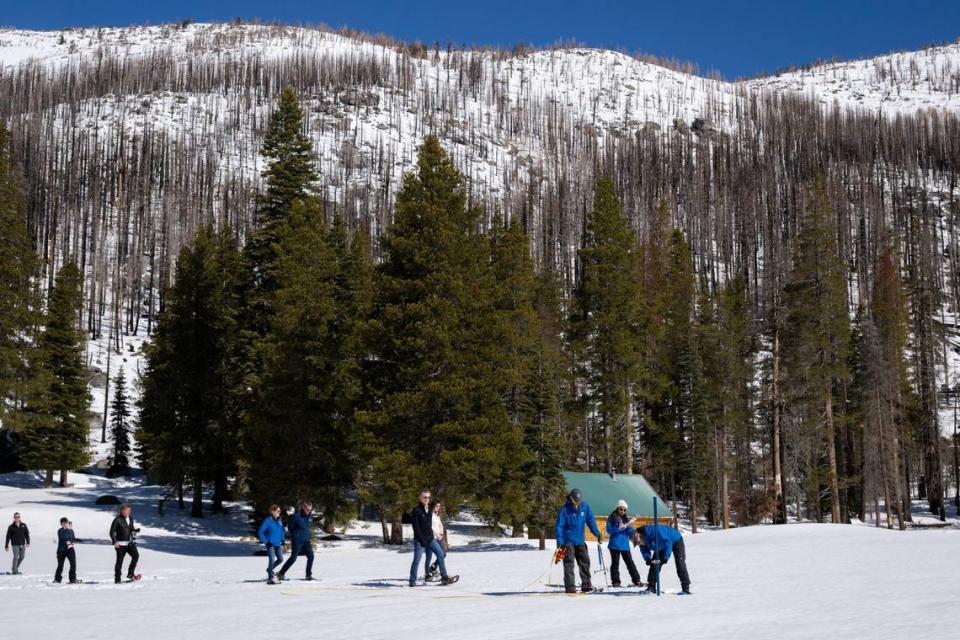How much water can Stanislaus farms and cities expect as growing season gets underway?
- Oops!Something went wrong.Please try again later.
Winter brought just average rain and snow to Stanislaus County’s main watershed, but most farmers will get abundant supplies.
That’s because reservoirs continue to hold much of the runoff from last year’s truly wet conditions. Only in parts of the West Side will water be limited.
The storms also boosted groundwater, which is part of the supply in many places.
City residents, too, can expect no cutbacks, but they still have to follow rules against outdoor watering in the afternoon. Too much demand on a hot summer day can tax the distribution system.
Most of the county’s water comes from the central Sierra Nevada snowpack. It was at 107% of the historical average for April 3, the California Department of Water Resources reported.
State leaders reminded residents that drought can return, such as the dry times from 2020 to 2022. And they said climate change will mean more rain and less snow in the decades ahead.
“Average is awesome,” DWR Director Karla Nemeth said Tuesday at a snow-measuring site on Highway 50. “But average may be becoming less and less common of a feature for snowpack in California.”
Nemeth took part in a media event held monthly each winter to update the conditions. California gets storms mainly from November through March, followed by several warm, dry months.
Gov. Gavin Newsom also was on hand, and he reinforced the climate message. “We recognize the world we’re living in,” he said. “We recognize the trend lines into the future and we’re navigating them.”
MID, TID are flush with Tuolumne water
The Modesto and Turlock irrigation districts will have no limits this year on their Tuolumne River deliveries. To promote groundwater recharge, farmers can get extra water at season’s end, assuming they do flood irrigation rather than drip lines or sprinklers.
TID serves about 149,000 acres in southern Stanislaus and northern Merced counties. MID has about 58,000 acres in Stanislaus.
MID also will have a full supply for the treatment plant that has provided part of the city of Modesto’s water for three decades. It has reduced reliance on wells, which can exceed safety standards at times.
Turlock and Ceres residents now have the same arrangement with TID, thanks to the November completion of a river treatment plant. The cities continue to tap groundwater, too.
MID and TID share Don Pedro Reservoir, one of the state’s largest storage sites. As of Wednesday, it was at 83% of its capacity, DWR said. That is 111% of the historical average for April 3.
San Francisco diverts part of the Tuolumne far upstream for use in its Hetch Hetchy Water & Power System. No rationing is planned for the two dozen Bay Area locales that contract for this supply.

Stanislaus River and West Side
The Oakdale Irrigation District will have full supplies from the Stanislaus River for its 82,000 or so acres. It and the South San Joaquin Irrigation District have first call on water stored in New Melones Reservoir.
SSJID serves about 55,000 acres of farmland and also supplements wells in the cities of Escalon, Lathrop, Manteca and Tracy. No cutbacks are planned this year.
New Melones is at 84% of its capacity and 135% of the average for this time of year, DWR said.
Most of the West Side is served by the federal Central Valley Project. The water is pumped from the Sacramento-San Joaquin Delta to as far south as Kern County.
Four districts totaling about a quarter-million acres, between Crows Landing and Mendota, will get 100% of their federal supply this year. The guarantee is part of a 1930s agreement to stop drawing directly from the San Joaquin River in exchange for CVP water. These agencies are the Central California Irrigation District, the San Luis Canal Co., the Firebaugh Canal Water District and the Columbia Canal Co.
Other CVP contractors are getting only 35% this year because of junior water rights and protections for fish at the massive Delta pumps. They have received zero water during droughts.
These districts also can use wells or purchase water from more plentiful areas. And treated wastewater from Modesto, Ceres and Turlock provides about a third of the supply for the Del Puerto Water District. It has about 45,000 farmland acres along Interstate 5 between Vernalis and Santa Nella.
The Sacramento Bee contributed to this report.

